Are you interested in the deep cultural roots of tiger tattoo designs? They have been a key part of Japanese art for ages. In Japan, the tiger stands for strength, courage, and power. This makes it a favorite in traditional tattoo art.
The history of japanese tiger tattoo designs goes back to ancient times. Over the years, they’ve been shaped by many cultural and artistic traditions. Today, these designs are loved worldwide, mixing old and new styles beautifully.
Key Takeaways
- Discover the rich history and cultural significance of tiger tattoo designs in Japan.
- Explore the various meanings associated with these powerful symbols.
- Learn about the different styles and techniques used to create stunning tiger tattoos.
- Find inspiration for your own unique tiger tattoo design.
- Get insights into the cultural and artistic traditions that influence japanese tiger tattoo designs.
The Cultural Significance of Tigers in Japanese Art
Tigers hold a special place in Japanese art, rooted in myths and stories. They symbolize many aspects of Japanese culture and values.
Tigers in Japanese Mythology and Folklore
In Japanese stories, tigers are seen as mighty and regal. They stand for courage, strength, and protection against evil. These ideas deeply shape Japanese tiger tattoos.
- Courage and bravery in tough times
- Strength and power, both physical and spiritual
- Protection against bad spirits and luck
The Tiger as a Symbol in Traditional Japanese Art
In traditional Japanese art, the tiger is a symbol of balance and harmony
The tiger’s role in traditional art has greatly influenced Japanese tiger tattoos. They are popular for those wanting to show these qualities.
The History of Japanese Tiger Tattoo Designs
The history of Japanese tiger tattoos is rich and complex, spanning centuries. It has been shaped by cultural and social factors. Understanding this history can deepen your appreciation for this art form.
Origins in the Edo Period
Japanese tiger tattoos started in the Edo period (1603-1868). Tattoos were used to show social status back then. The tiger, symbolizing power and strength, became a favorite in tattoo art.
Tattoos were not just for looks but also carried deep cultural and spiritual meaning. During this time, tattoo art was highly refined. Techniques and designs were passed down through generations.
Evolution Through the Meiji Era
The Meiji era (1868-1912) changed how tattoos were seen in Japan. As the country modernized, tattoos were linked to criminality, leading to a drop in popularity. Yet, this era also brought Western art’s influence on Japanese tattoo designs, introducing new techniques and motifs.
Despite the negative views, traditional tattoo artists kept their craft alive in secret.
Modern Revival and Global Popularity
In recent years, Japanese tiger tattoos have seen a comeback, both in Japan and worldwide. The growing interest in traditional Japanese art and culture has boosted tattoo appreciation. Modern tattoo artists have mixed traditional designs with new styles and techniques.
As a result, Japanese tiger tattoos have become a favorite for those looking for a meaningful and beautiful tattoo.
Symbolism and Meaning Behind Japanese Tiger Tattoos
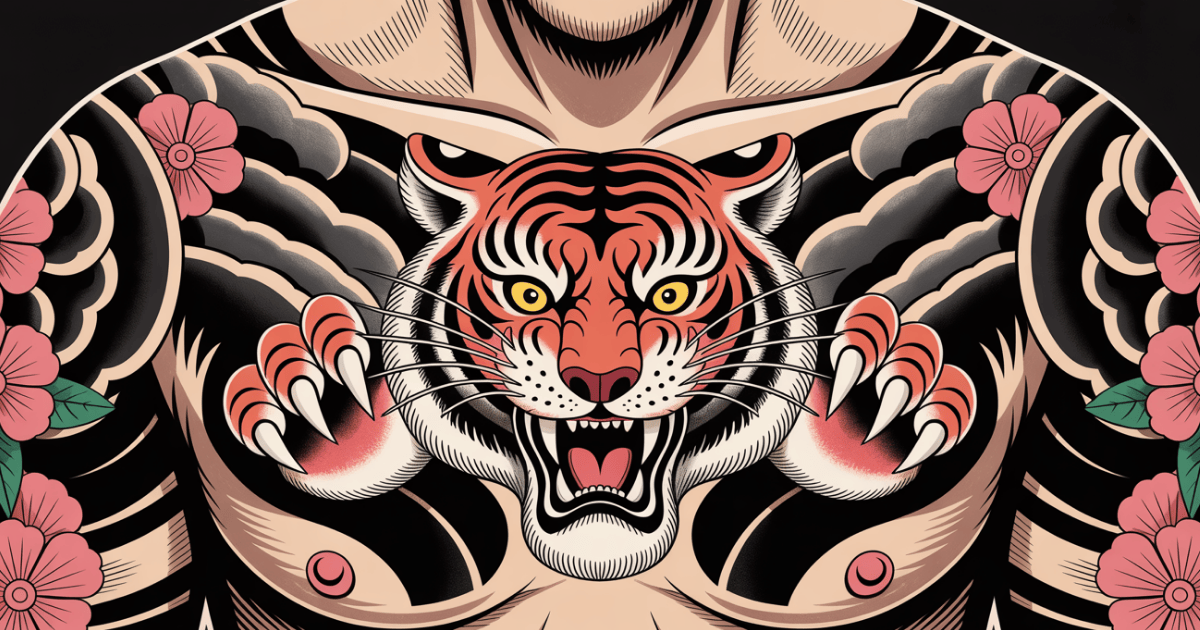
Tigers in Japanese tattoo art symbolize strength, courage, and protection. They also represent harmony. These tattoos are not just beautiful; they hold deep meanings from Japanese culture and myths.
Strength, Courage, and Power Representations
The tiger symbolizes strength, courage, and power in Japanese culture. It is one of the twelve zodiac animals and a symbol of the warrior class. The tiger reminds us of our inner bravery and resilience.
Protection Against Evil Spirits and Bad Luck
Japanese tiger tattoos also protect against evil spirits and bad luck. The tiger’s fierce reputation keeps away bad forces. This belief comes from Japanese folklore, where tigers guard against misfortune.
Balance, Harmony, and Yin-Yang Symbolism
The tiger symbolizes balance and harmony, paired with the dragon. Together, they show the yin-yang principle. This balance is key in Japanese tattoos, teaching us about life’s equilibrium.
Understanding Japanese tiger tattoos reveals their deep meaning. These tattoos symbolize strength, protection, and balance. They are loved worldwide for their beauty and significance.
Traditional Japanese Tiger Tattoo Styles
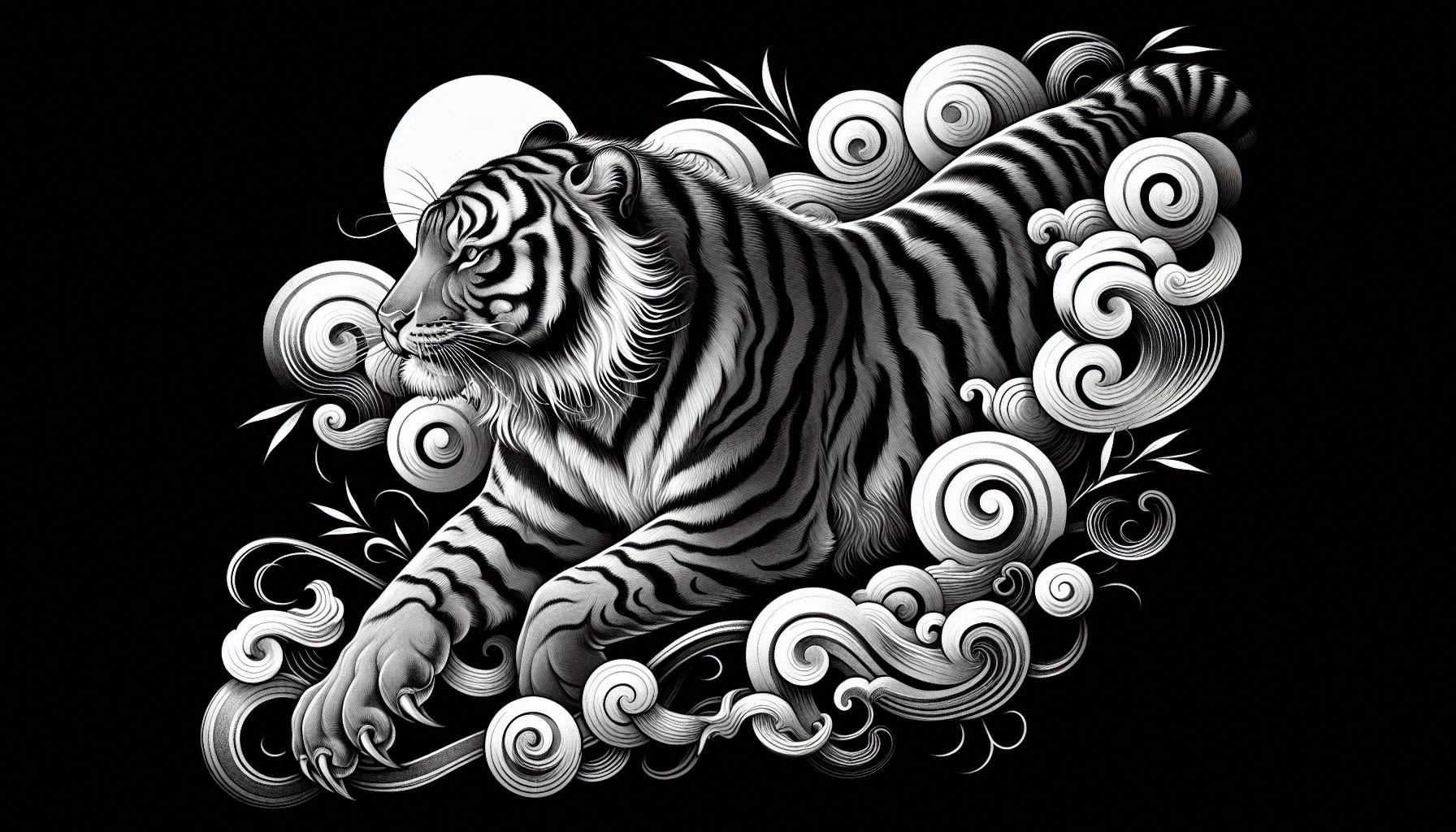
Traditional Japanese tiger tattoos blend history, mythology, and art. They show a wide range of styles. These tattoos have been shaped by many art forms and techniques over centuries.
Bolder Lines: Irezumi Style Characteristics
The Irezumi style is known for bold black lines and vibrant colors. It uses shading and gradient techniques for depth. Artists focus on every detail, making each tattoo a work of art.
Artistic Influences: Ukiyo-e Inspired Designs
Ukiyo-e, a Japanese art form from the 17th to 19th centuries, has influenced tattoos. Its woodblock prints of natural scenes, like tigers, are seen in Japanese tiger tattoos. This adds cultural depth to the designs.
Vibrant Colors: Traditional Color Palettes and Techniques
Traditional Japanese tiger tattoos use bright colors like black, red, orange, and green. Artists use hand-poking or traditional tools to create these colors. The colors not only look great but also have symbolic meanings.
| Style | Characteristics | Influences |
|---|---|---|
| Irezumi | Bold lines, vibrant colors, intricate details | Traditional Japanese tattooing |
| Ukiyo-e | Natural imagery, composition | Japanese woodblock prints |
| Traditional Color Palettes | Vibrant colors, symbolic meanings | Cultural and artistic traditions |
Popular Japanese Tiger Tattoo Designs and Compositions
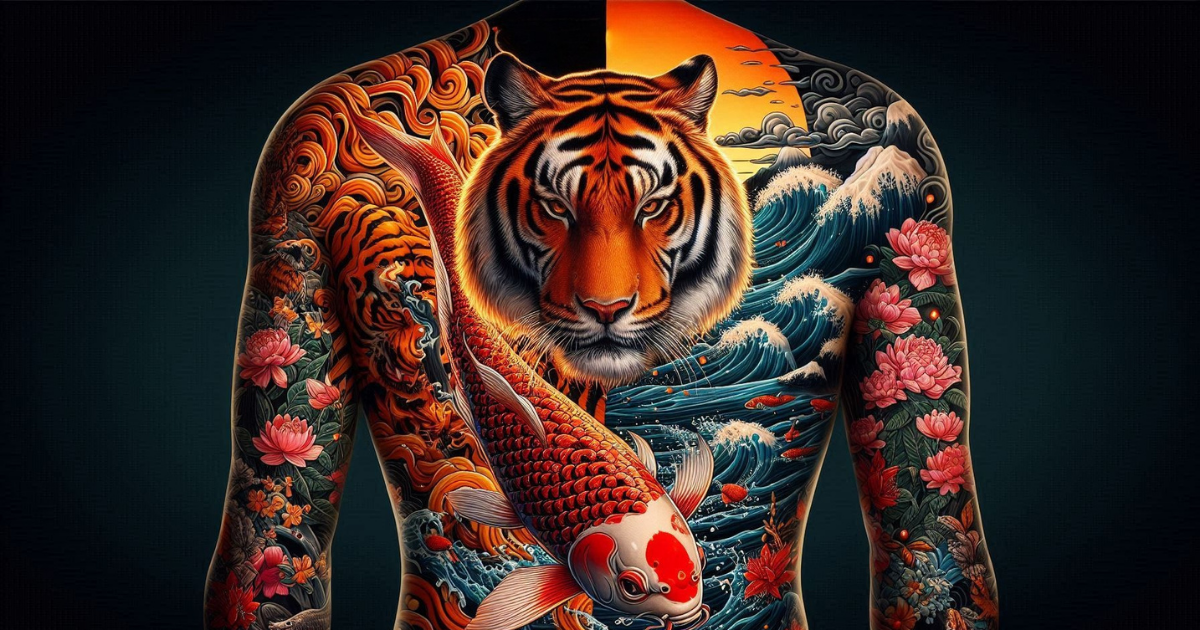
Thinking about a Japanese tiger tattoo? You’ll find many designs and compositions that are both symbolic and beautiful. These tattoos often mix animals and elements, making them meaningful and stunning.
Tiger and Dragon Combinations
A tiger and dragon together is a common and powerful design in Japanese tattoos. The tiger stands for earth, while the dragon is from heaven. This pair shows balance and unity of opposites.
- Symbolic Meaning: Balance, harmony, and the unity of opposites.
- Design Elements: Often shown in a fierce battle or intertwined, showcasing their complementary strengths.
This design is not just eye-catching but also carries deep cultural meaning. It’s a top choice for those looking for a tattoo with significance.
Tiger with Bamboo, Peonies, or Cherry Blossoms
Adding bamboo, peonies, or cherry blossoms to a tiger tattoo adds more depth. Bamboo stands for strength and flexibility. Peonies mean good fortune and prosperity. Cherry blossoms remind us of life’s fleeting beauty.
- Bamboo: Adds a theme of endurance and adaptability.
- Peonies: Brings an element of wealth and happiness.
- Cherry Blossoms: Incorporates the concept of impermanence and the beauty of life.
These additions make the tattoo more visually appealing and symbolically richer.
Tiger in Water, Wind, or Mountain Elements
Putting a tiger in water, wind, or mountains adds more to the tattoo’s meaning. Water is about change and fluidity. Wind is for freedom and movement. Mountains stand for strength and stability.
- Water: Adds a dynamic element, symbolizing adaptability and transformation.
- Wind: Brings a sense of movement and liberation.
- Mountains: Grounds the design, representing solidity and permanence.
These elements, combined with the tiger, make a tattoo that’s both beautiful and full of symbolism. It can reflect the wearer’s journey or dreams.
Unique Elements of Japanese Tiger Tattoo Designs

Japanese tiger tattoos are loved for their unique design elements. They are not just beautiful; they also show Japan’s rich culture.
Distinctive Facial Expressions and Poses
These tattoos are famous for their dynamic poses and faces. The tigers are shown in strong poses, showcasing strength and agility. Their faces can be fierce or calm, making the tattoo more interesting.
Stylized Stripes and Fur Patterns
The tiger’s stripes and fur are stylized in these tattoos. Artists use detailed patterns and bold line work to show the fur. These patterns make the tattoo look alive and full of energy.
Background Elements and Composition Rules
Backgrounds are key in Japanese tiger tattoos, often featuring water, wind, or mountains. The design is carefully made to blend the tiger with its surroundings. This follows traditional Japanese beauty rules.
By mixing these unique elements, Japanese tiger tattoos get a special look. They are both culturally rich and visually stunning.
Ideal Placement for Japanese Tiger Tattoo Designs

Choosing the right spot for your Japanese tiger tattoo is key. It depends on the design’s size, complexity, and what you like.
Full Back and Bodysuit Pieces
A full back tattoo is a top pick for Japanese tiger designs. It lets you show off detailed art in a big way.
It’s perfect for big designs with extra elements like cherry blossoms or dragons.
Sleeve and Half-Sleeve Options
Sleeve and half-sleeve tattoos are also favorites. They give you a great space for your tiger design.
- A full sleeve can show a tiger in action.
- A half-sleeve can highlight the tiger’s face or upper body.
Chest, Thigh, and Smaller Placement Considerations
For smaller or more hidden designs, think about the chest or thigh.
These spots are great for simple Japanese tiger tattoos or if you want something less bold.
In the end, the best spot for your Japanese tiger tattoo is what feels right to you.
Finding the Right Japanese Tattoo Artist
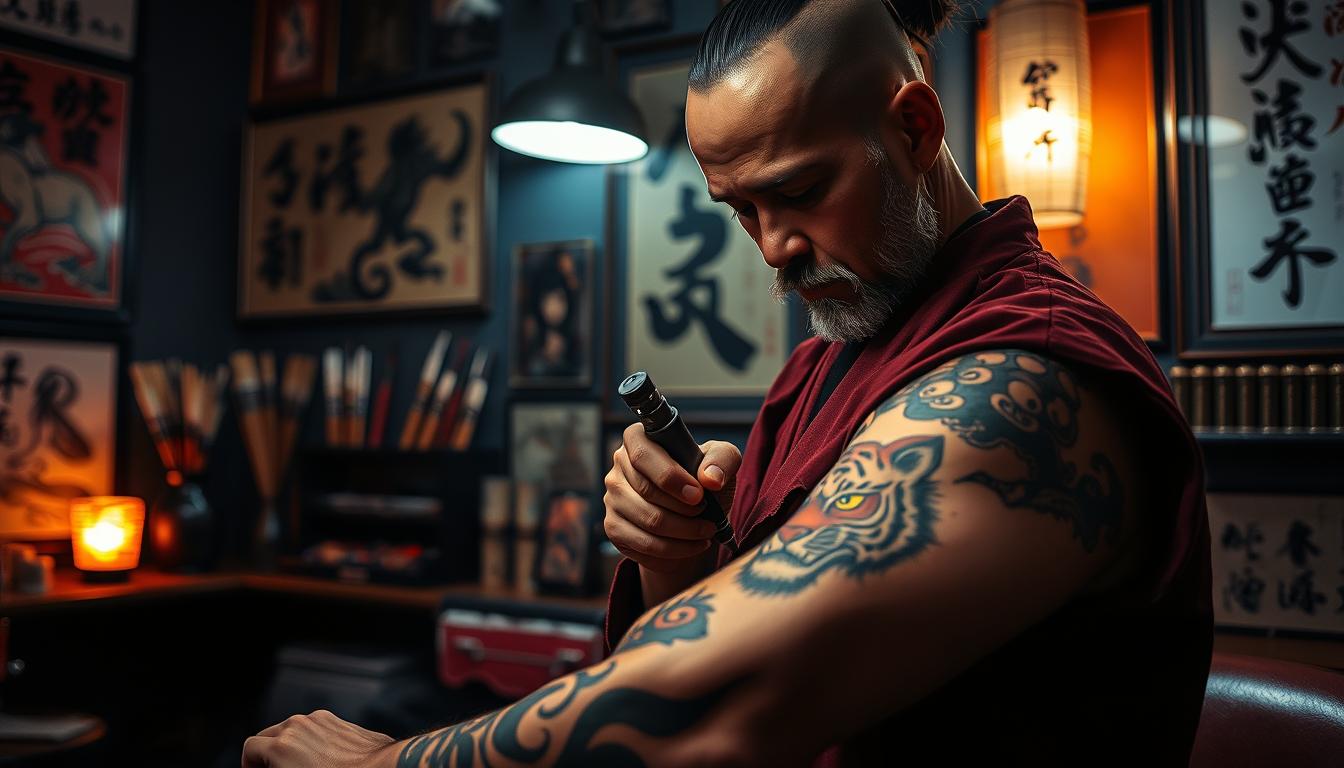
To get a beautiful and meaningful Japanese tiger tattoo, you need to find a skilled artist. The process involves several key steps. These steps help you make an informed decision.
What to Look for in a Japanese Style Specialist
When searching for a Japanese tattoo artist, look for experience in Japanese style tattooing. Check their portfolio to see if their work matches your desired design. A reputable artist will have a portfolio that shows their expertise in traditional Japanese tattooing techniques and styles.
Questions to Ask Before Committing
Before committing to a tattoo artist, ask about their experience, design process, and aftercare instructions. It’s important to understand their approach to creating a custom design that meets your expectations. Some questions to consider include: “Can you share examples of your previous work?” and “How do you ensure the design is tailored to my preferences?”
Best Japanese Tiger Tattoo Artists in the United States
Researching top artists in the field can help you find the right fit. Some renowned Japanese tattoo artists in the United States include:
| Artist Name | Location | Specialty |
|---|---|---|
| Don Ed Hardy | California | Traditional Japanese |
| Horiyoshi III | Massachusetts | Tattoo artistry, Japanese style |
| Mike Marshall | New York | Japanese tattoo designs |
By researching and reaching out to these artists, you can find the perfect match for your Japanese tiger tattoo.
The Process of Getting a Japanese Tiger Tattoo

Getting a Japanese tiger tattoo is a journey with important steps. Knowing these steps helps you prepare and get a tattoo that means a lot to you.
Consultation and Design Development
First, you’ll talk to your tattoo artist. You’ll share your ideas, the meaning you want, and the style you like. Your artist will help make your tattoo special and meaningful.
Time, Pain, and Cost Considerations
Think about the time, pain, and cost of your tattoo. The size and detail of your design affect how many sessions you’ll need. Each session is long. Pain and cost vary based on the artist, location, and design.
Aftercare for Japanese Style Tattoos
Aftercare is key for your tattoo’s health and look. Your artist will tell you how to keep it clean, apply ointment, and avoid sunlight. Following these steps helps your tattoo heal well and stay bright.
| Aftercare Tip | Description | Importance Level |
|---|---|---|
| Keep it Clean | Wash your tattoo with mild soap and lukewarm water | High |
| Apply Ointment | Use a fragrance-free lotion or aftercare cream as recommended | High |
| Avoid Sunlight | Direct sunlight can cause fading and damage | Medium |
🔥 Ready to Find Your Perfect Tiger Tattoo?
Unlock 30,000+ Professional Tattoo Designs from top artists around the world with Miami Ink Tattoo Designs – the ultimate design vault trusted by over 45,000 tattoo lovers!
✅ Why You’ll Love It:
- Access 60+ tattoo categories, including Tiger Tattoos
- Pin and save your favorite designs easily
- Get inspired with exclusive tattoo fonts, prints & videos
- Works on any device, anytime – 24/7 access
- Includes the legendary Tattoo Bible PDFs
🎯 Don’t settle for average ink. Get instant access and bring your tiger tattoo vision to life!
👉 Click Here to Explore the Designs Now!
Conclusion: Embracing the Power of Japanese Tiger Tattoo Designs
Exploring japanese tiger tattoo designs has shown you their deep cultural and personal value. These tattoos are not just beautiful; they also hold significant symbolic meanings. Many people find these meanings powerful and meaningful.
Choosing a japanese tiger tattoo means you value its beauty and cultural background. These tattoos symbolize strength, courage, and protection against bad luck. They offer a unique way to express your personality.
Thinking about getting a japanese tiger tattoo? Remember the skill and artistry that goes into each piece. With the right artist, your tattoo will be both personal and deeply meaningful.
FAQ
What is the cultural significance of tigers in Japanese art?
In Japanese art, tigers symbolize strength, courage, and protection. These qualities influence the design and meaning of Japanese tiger tattoos.
What is the history of Japanese tiger tattoo designs?
Japanese tiger tattoos started in the Edo period. They evolved through the Meiji era and saw a modern revival. Historical events have shaped their popularity and perception.
What do Japanese tiger tattoos symbolize?
Japanese tiger tattoos symbolize strength, courage, power, and protection. They also represent balance and harmony, making them a meaningful tattoo choice.
What are the characteristics of traditional Japanese tiger tattoo styles?
Traditional Japanese tiger tattoos have distinct color palettes and techniques. They follow specific composition rules, giving them a unique aesthetic.
What are some popular Japanese tiger tattoo designs and compositions?
Popular designs include tiger and dragon combinations. There are also tigers with bamboo, peonies, or cherry blossoms. Tigers in water, wind, or mountains add to the tattoo’s meaning and beauty.
How do I choose the ideal placement for my Japanese tiger tattoo?
Consider size, complexity, and personal preference when choosing a placement. Options include full back, sleeve, and smaller placements.
How do I find a skilled Japanese tattoo artist?
Research top artists and look for specialists in Japanese style. Ask about their experience and techniques. Review their portfolios to find the right artist for your tattoo.
What is the process of getting a Japanese tiger tattoo?
The process starts with consultation and design development. Then comes the tattooing process. Aftercare is crucial for healing and maintaining your tattoo.
What are some unique elements of Japanese tiger tattoo designs?
Unique elements include distinctive facial expressions and poses. Stylized stripes and fur patterns add to the tattoo’s distinctiveness. Background elements and composition rules also play a role.
Are there any specific aftercare instructions for Japanese style tattoos?
Yes, keep the tattoo clean and apply ointment. Avoid direct sunlight and soaking. This ensures proper healing and vibrant colors.
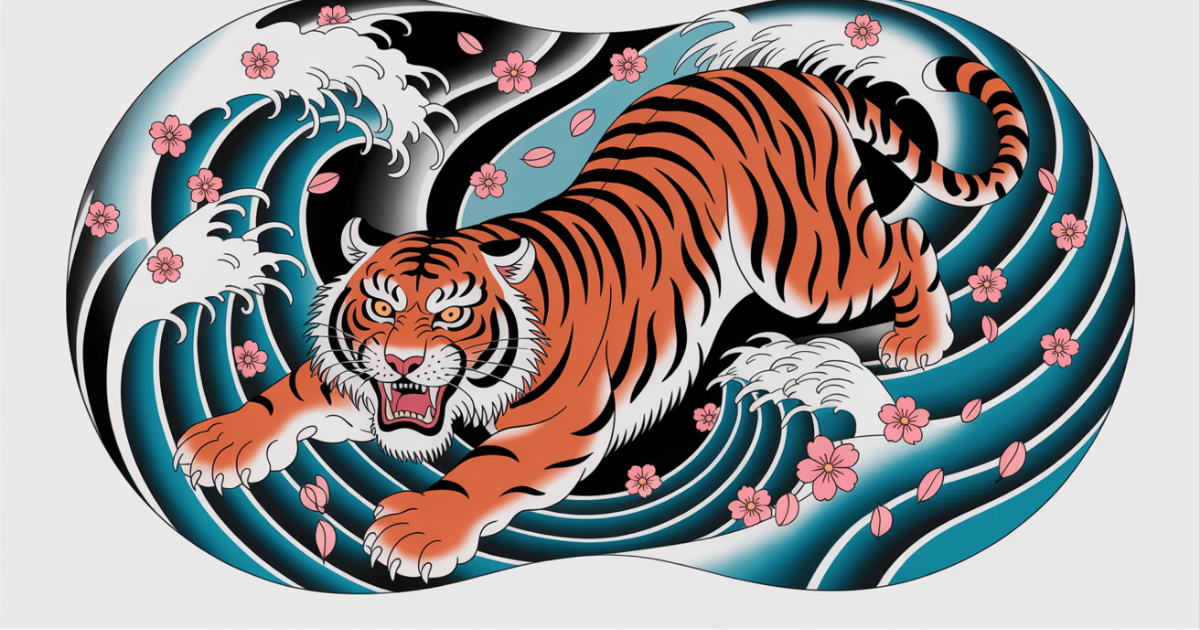





Pingback: Roaring Beauty: 30 Unique Tiger Tattoo Designs for Women
Pingback: 50+ Small Meaningful Symbol Tattoo Designs for Men (2025 Guide)
Pingback: Snake Tattoo Meaning by Placement: Wrist, Spine, Ankle & More
Pingback: Embrace the Wild: Explore Stunning Tiger Tattoo Designs for Men